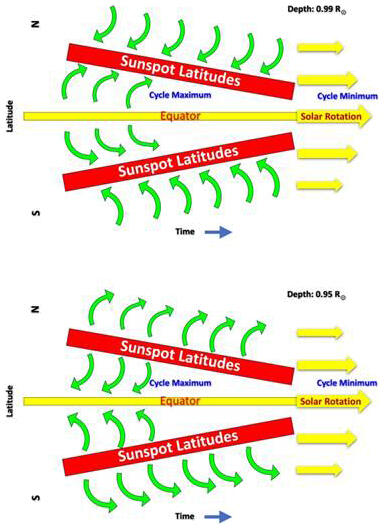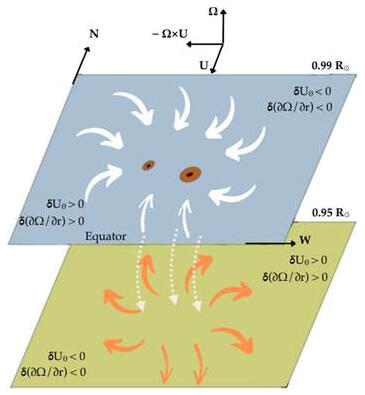太陽内部プラズマ流、黒点の11年周期と同期して変化 インド
インド科学技術省(MoST)は4月29日、科学技術庁(DST)傘下のインド宇宙物理学研究所(IIA)が主導し米国のスタンフォード大学や米国の国立太陽天文台(NSO)と共同で、太陽表面直下の表面近傍シアー層(NSSL)におけるプラズマ流動が、11年周期の太陽活動(黒点周期)と同期して変化していることを発見したと発表した。研究成果は学術誌The Astrophysical Journal Lettersに掲載された。
研究チームは、NASAの太陽観測衛星ソーラー・ダイナミクス・オブザーバトリー(SDO)やNSOのグローバル振動(GONG)ネットワークの10年以上のデータを活用し、日震学を用いて太陽内部を通過する音波を解析した。その結果、太陽表面付近のプラズマ流は、活動的な黒点の緯度に向かって収束し、NSSLの中層で反転して外向きに流れる循環セルを形成していることが確認された。これらの流れは、太陽の回転やコリオリ力の影響を強く受けているが、太陽全体に広がる「ねじれ振動」と呼ばれる大規模な流れの原動力ではないことも明らかになった。
研究を主導したS.P.ラジャグル(S.P. Rajaguru)教授は、「太陽内部の気象パターンがどのように形成され進化していくのかを解明できたことは画期的です。太陽活動は宇宙天気に影響を与え、人工衛星や電力網、通信システムに混乱を引き起こす可能性があります」と語る。本研究は、太陽内部の流動が磁気活動とどう関連しているかについての理解を深めるとともに、太陽の全体的なダイナミクスを駆動するより深い層に潜む他の要因がある可能性を示唆している。

Fig 1: Depictions of how flow structures near the surface (0.99 solar radii) and at a deeper layer near (0.95 solar radii) develop as sunspots appear and evolve over time (over the 11-year solar cycle). The directions of swirly motions in the northern and southern hemispheres of the Sun are determined by the Coriolis force, just the same way it shapes the storm systems on the Earth.

Fig 2. Sketch showing the Coriolis force mediated average flow structures around active regions in the northern hemisphere of the Sun. The labels depict the signs of residuals in meridional flows, δUθ, and that in resulting residual rotational shear, δ(∂Ω/∂r), for the two depths, 0.99 and 0.95 Rsun which mark the radial boundaries of the NSSL. Figure Artwork Credit: Amrita Rajaguru
(出典:いずれもPIB)
サイエンスポータルアジアパシフィック編集部





